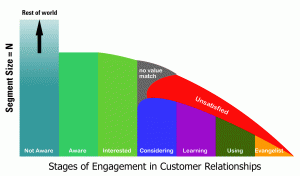At Dreamforce 2014 (Salesforce.com’s annual event), executives from Louis Vuitton showed how their founder carried a little black book where he captured his client interactions. This diary helped him engage in a personalized and meaningful dialog with customers.
 Fast forward to today and the talk of “Clienteling” is everywhere. It is possible now to make information available to the store associates which can help them engage and service the customers much better. Everything is fair game – past transactions, social interactions, coupons redeemed, coupons not redeemed, merchandise browsed both online and in the store, among many other things.
Fast forward to today and the talk of “Clienteling” is everywhere. It is possible now to make information available to the store associates which can help them engage and service the customers much better. Everything is fair game – past transactions, social interactions, coupons redeemed, coupons not redeemed, merchandise browsed both online and in the store, among many other things.
Think about the possibilities:
Scenario: You visit a banana republic store, and store associate is able to help you with the items that are on your wishlist, the nice jacket you can’t find the right size for, the shirt you were browsing online and liked on Facebook. Not only that, the associate can pull up details from your last visit and finally help you get into the jacket you were looking for last time. And she can apply the coupon they sent you by email which you obviously can’t find.
The result: You are engaged more than ever with Banana Republic. Its not just a store any more. You will likely not ignore their emails any more, and they can get you to plan your wardrobe using their app – a big win for apparel retailers.
And now lets get to banking.
Scenario: You visit a PNC bank branch. The branch associate walks up to you and instead of asking “how can I help you”, introduces himself and pulls your profile up on her iPad. You went in for a cashiers check, but the associate already knows that – based on the fact that you tried to do that online an hour ago and are just a little frustrated. That’s squared away in 2 minutes, and then the associate helps you with the retirement planning question you had (based on your online research that’s available on his iPad). Not only that, she quickly shows you your financial profile, gets your 401K and other funds added to your online account so you can view them in one place. You walk away with a beautiful document that shows you step by step on how to get your finances in order, and what to do with the 529 you have for your kid.
The result: The bank is not just a “transaction” place any more. They are your best friends and an advisor. And they get what other banks dream of: Your confidence.
These scenarios are fictional of course but not far from reality. They can be extended to many different use cases for your customers. As you can see they tremendously help employee engagement as well.
There is no doubt that the CX (Customer Experience) discussion is ushering in an exciting era of customer service and sales. The premise is that by providing a seamless experience to the customers, and by offering them the right product at the right time, and the right advice, we will not only secure higher sales, but also higher customer satisfaction and stronger loyalty.
If we extract the fundamentals of this exciting story line, the most important aspects can be applied not only to other consumer oriented areas such as banking, insurance, travel and hospitality, but also to many other areas that have not yet caught up to the marketing bandwagon. For example, how about the area of investments management, or the business of B2B industrial distribution? These areas don’t look that cool, but as we review case studies of what several firms in these areas are doing, the “Clienteling” concept really starts to shine. And we come to see that these exciting initiatives are hidden under other topics such as sales process improvements.
For each of these, the all important question of customer engagement is driven through helping the customer achieve their goals. And in each of these cases, the goals are beyond the transactions themselves.
- In the book, “The Challenger Sale”, the authors outline how industrial distributor Grainger was able to transform its relationship with customers by showing them how unplanned procurement was costing them a fortune. By doing so, Grainger moved from being a transactional supplier with the largest catalog as its primary selling point, to being a strategic partner with the ability to help clients optimize their MRO spending.
- When the Retail Design Institute’s 2014 Store of the Year award was presented to a concept for Umpqua bank, what was really being set up was Clienteling. How does a new branch design do that? In essence, the design focuses on collaboration and relaxation. In turn, this change will result in the bank branch becoming a marketplace, and will help it move away from just being a seller of products and services.
As more consultative capacity is automatically added through such designs, we can only hope that product sales will evolve towards a joint effort to meet customer goals. And commoditization of the underlying product itself will actually become an enabler! The dialog will naturally move away from price to value. For companies that can anticipate this transformation and take the right steps, this will become an important competitive advantage.
Photo credit: chrisheuer / Foter / CC BY-NC-SA
